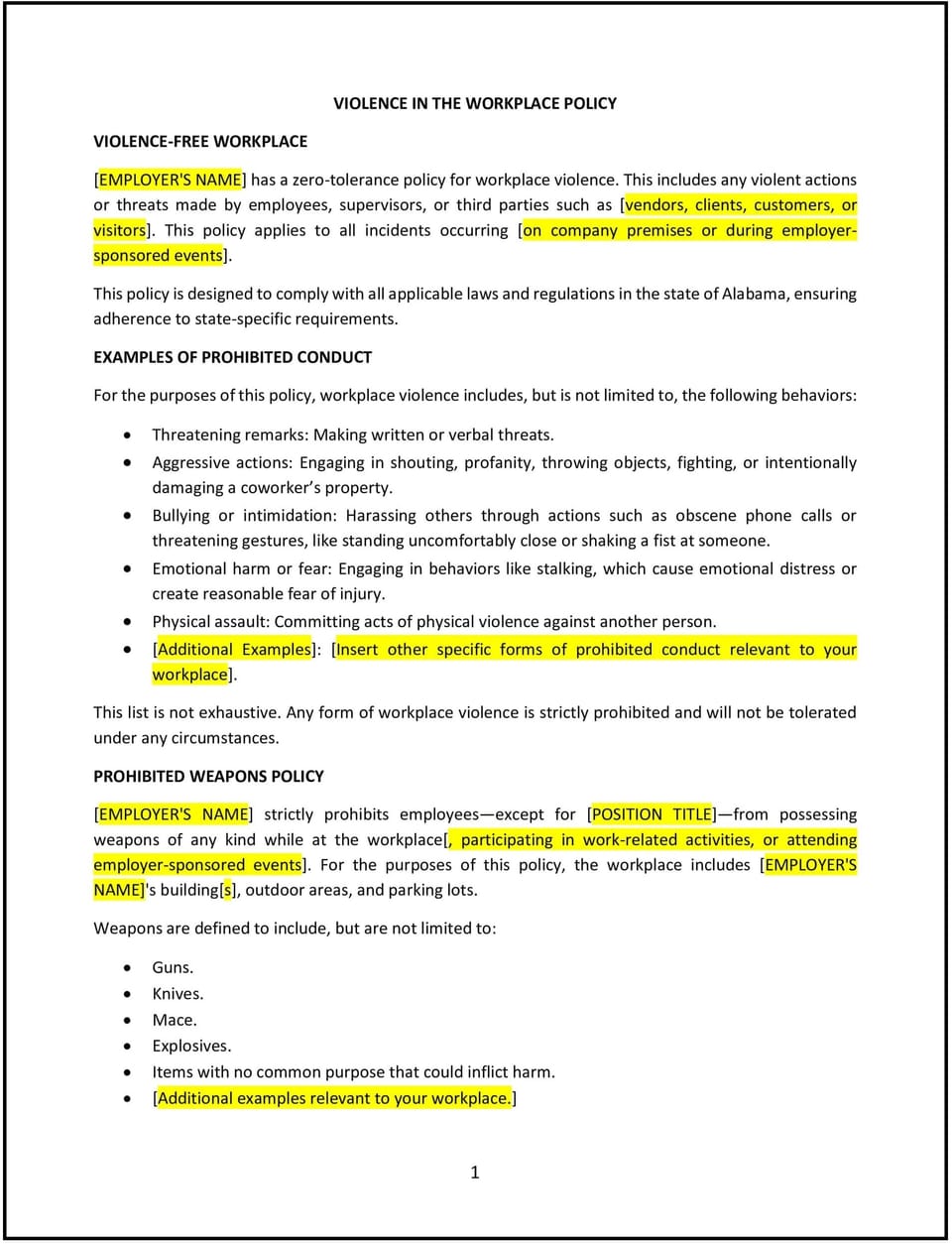Violence in the workplace policy (Alabama): Free template

Violence in the workplace policy (Alabama)
A violence in the workplace policy establishes clear guidelines to prevent, address, and manage incidents of violence or threats in the workplace. For SMBs in Alabama, this policy helps maintain a safe and secure environment for employees, customers, and visitors by promoting proactive measures and swift responses to incidents.
This policy defines prohibited behaviors, outlines reporting procedures, and specifies the company’s commitment to preventing workplace violence through awareness, training, and appropriate actions.
How to use this violence in the workplace policy (Alabama)
- Define workplace violence: Clearly outline behaviors considered violent, such as physical harm, verbal threats, intimidation, harassment, or the presence of weapons in the workplace.
- Establish reporting procedures: Provide a straightforward process for employees to report incidents confidentially, including the designated contact (e.g., HR or a safety officer).
- Promote zero tolerance: Emphasize the company’s zero-tolerance stance on violence and the consequences for violating this policy.
- Include prevention measures: Highlight proactive steps, such as conflict resolution training and workplace security measures, to minimize risks.
- Detail response protocols: Specify how incidents will be investigated and addressed, including immediate actions to ensure safety and longer-term measures to prevent recurrence.
Benefits of using a violence in the workplace policy (Alabama)
A workplace violence policy ensures a structured approach to handling threats, fostering a safer environment. Here’s how it helps:
- Enhances safety: Protects employees, customers, and visitors by addressing risks proactively and effectively.
- Supports compliance: Aligns with Alabama and federal laws, such as OSHA’s general duty clause, requiring employers to provide a safe workplace.
- Reduces liability: Minimizes the company’s exposure to legal risks and reputational damage by establishing clear procedures and standards.
- Improves morale: Demonstrates the company’s commitment to employee well-being, creating a positive and secure workplace culture.
- Encourages accountability: Ensures consistent enforcement of rules, building trust among employees.
Tips for implementing a violence in the workplace policy (Alabama)
- Conduct risk assessments: Regularly evaluate workplace vulnerabilities to identify and address potential risks of violence.
- Provide employee training: Offer conflict resolution and violence prevention training to raise awareness and equip employees with tools to manage tense situations.
- Secure the workplace: Implement physical security measures, such as controlled access points, surveillance systems, and alarm protocols.
- Create a crisis response team: Designate a team responsible for handling workplace violence incidents, ensuring rapid and effective responses.
- Communicate clearly: Ensure employees understand the policy, reporting procedures, and their role in maintaining a safe environment.
Q: What behaviors should SMBs define as workplace violence?
A: Workplace violence includes physical assaults, verbal threats, intimidation, harassment, and any behavior that creates a hostile or unsafe environment.
Q: How can SMBs encourage employees to report incidents?
A: Create a confidential and non-retaliatory reporting process, reassuring employees that their safety and concerns will be taken seriously.
Q: What steps should be taken if violence occurs in the workplace?
A: Immediate actions include securing the area, contacting law enforcement if necessary, and ensuring the safety of all employees before beginning an investigation.
Q: Are SMBs required to provide training on workplace violence prevention?
A: While not always legally mandated, training is highly recommended to enhance awareness and preparedness, aligning with best practices for workplace safety.
Q: Can this policy apply to threats made outside of work?
A: Yes, threats made outside of work that impact the workplace or employee safety should be addressed under this policy.
Q: How often should this policy be reviewed?
A: The policy should be reviewed annually or after any significant incidents to incorporate lessons learned and updates to best practices.
This article contains general legal information and does not contain legal advice. Cobrief is not a law firm or a substitute for an attorney or law firm. The law is complex and changes often. For legal advice, please ask a lawyer.


